The following material has been sourced from the Australian Institute of Health and Welfare
Ovarian cancer statistics for mortality (deaths) incorporate ICD-10 cancer code C56 (Malignant neoplasm of ovary) only. For incidence, survival and prevalence, statistics also include ICD-10 cancer codes C57.0, C57.8 (with histologies 8441, 8460, 8461) for serous carcinomas of the fallopian tube.
New cases
In 2019, there were 1,625 new cases of ovarian cancer (incl. serous carcinomas of the fallopian tube) diagnosed in Australia. In 2023, it is estimated that 1,786 new cases of ovarian cancer (incl. serous carcinomas of the fallopian tube) will be diagnosed in Australia. In 2023, it is estimated that a female has a 1 in 87 (or 1.2%) risk of being diagnosed with ovarian cancer (incl. serous carcinomas of the fallopian tube) by the age of 85.
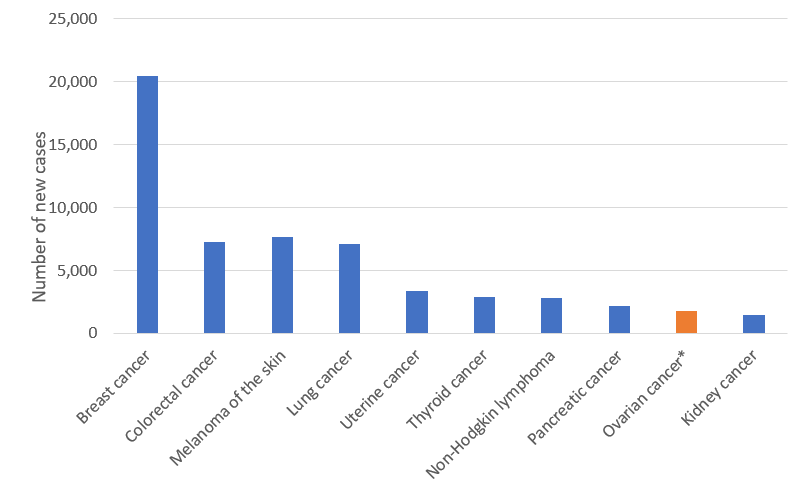
Notes
- Data sourced from AIHW Cancer Data in Australia 2023 web report and supplementary data tables
- More information about incidence rates for ovarian cancer over time, by age, sex, Indigenous status, remoteness, and socioeconomic status (SES) can be found on the NCCI website in the ‘Cancer incidence’ section (https://ncci.canceraustralia.gov.au/diagnosis/cancer-incidence/cancer-incidence)
- *Ovarian cancer includes serous carcinomas of the fallopian tube.
In 2019, the age-standardised incidence rate was 13 cases per 100,000 females. In 2023, it is estimated that the age-standardised incidence rate will be 13 cases per 100,000 females. The incidence rate for ovarian cancer (incl. serous carcinomas of the fallopian tube) is expected to increase with age, highest for those aged 85–89 years.
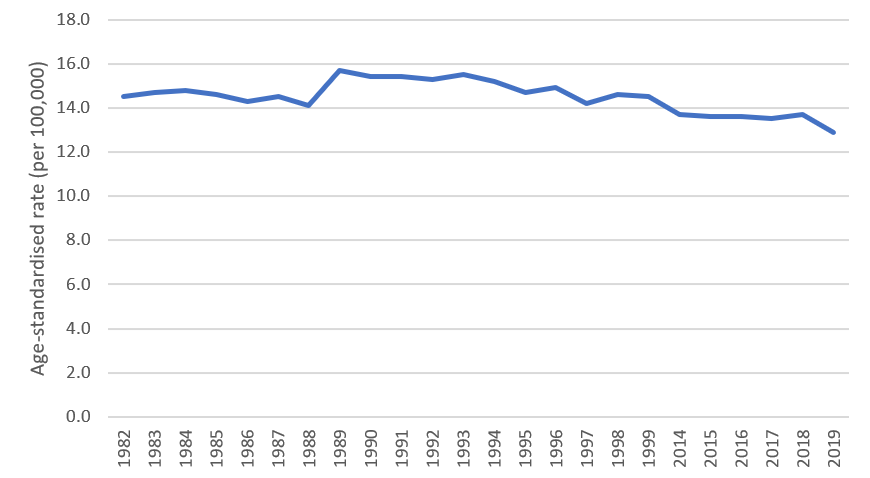
Notes
- Data sourced from AIHW Cancer Data in Australia 2023 web report and supplementary data tables
- Age standardised rates are standardised to the 2023 Australian Standard Population
- More information about incidence rates for ovarian cancer over time, by age, sex, Indigenous status, remoteness, and socioeconomic status (SES) can be found on the NCCI website in the ‘Cancer incidence’ section (https://ncci.canceraustralia.gov.au/diagnosis/cancer-incidence/cancer-incidence)
The number of new cases of ovarian cancer (incl. serous carcinomas of the fallopian tube) diagnosed increased from 837 females in 1982 to 1,625 in 2019. Over the same period, the age-standardised incidence rate decreased from 15 cases per 100,000 females in 1982 to 13 cases per 100,000 in 2019.
Deaths
In 2021, there were 1,053 deaths from ovarian cancer in Australia. In 2023, it is estimated that there will be 1,050 deaths. In 2023, it is estimated that a female has a 1 in 148 (or 0.68%) risk of dying from ovarian cancer by the age of 85.
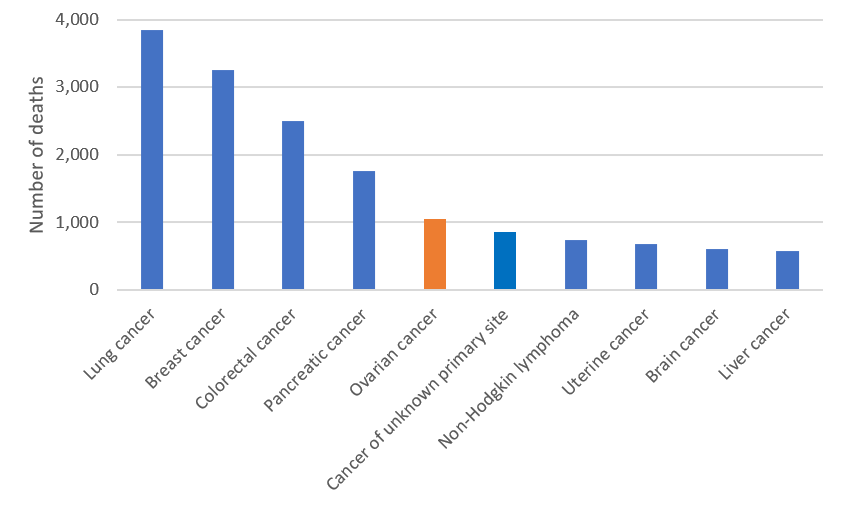
Notes
- Data sourced from AIHW Cancer Data in Australia 2023 web report and supplementary data tables
- Two sources are used for cancer mortality reporting rankings (National Mortality Database and Australian Cancer Database). Mortality data reported for cancer of unknown primary site, liver cancer and stomach cancer in the chart above is from the Australian Cancer Database. Data from the National Mortality Database is presented in-text unless it is unavailable. More information can be found at AIHW interim guidelines (https://www.aihw.gov.au/reports/cancer/cancer-data-in-australia/contents/cancer-data-commentaries/interim-guidelines-choosing-which-mortality-data)
- More information about mortality rates for ovarian cancer over time, by age, sex, Indigenous status, remoteness, and socioeconomic status (SES) can be found on the NCCI website in the ‘Cancer mortality’ section (https://ncci.canceraustralia.gov.au/outcomes/cancer-mortality/cancer-mortality)
In 2021, the age-standardised mortality rate was 7.9 deaths per 100,000 females. In 2023, it is estimated that the age-standardised mortality rate will be 7.5 deaths per 100,000 females. The mortality rate for ovarian cancer is expected to increase with age.
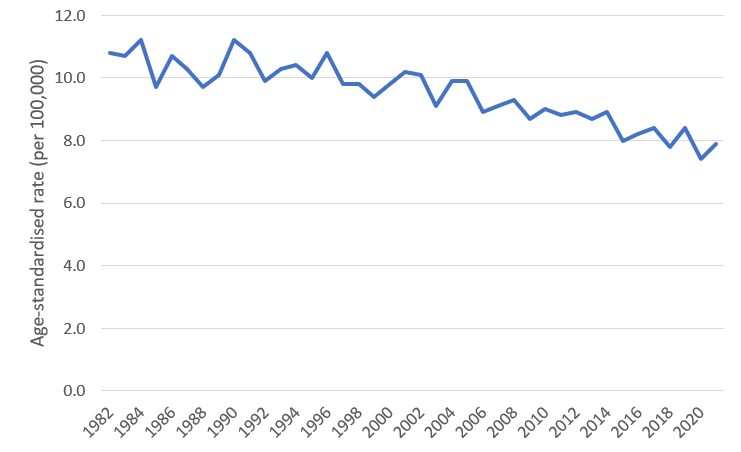
Notes
- Data sourced from AIHW Cancer Data in Australia 2023 web report and supplementary data tables
- Age standardised rates are standardised to the 2023 Australian Standard Population
- More information about mortality rates for ovarian cancer over time, by age, sex, Indigenous status, remoteness, and socioeconomic status (SES) can be found on the NCCI website in the ‘Cancer mortality’ section (https://ncci.canceraustralia.gov.au/outcomes/cancer-mortality/cancer-mortality)
The number of deaths from ovarian cancer increased from 587 females in 1982 to 1,053 in 2021. Over the same period, the age-standardised mortality rate decreased from 10.8 deaths per 100,000 females in 1982 to 7.9 deaths per 100,000 in 2021.
Survival
In 2015–2019, individuals diagnosed with ovarian cancer (incl. serous carcinomas of the fallopian tube) had a 49% chance of surviving for five years compared to their counterparts in the general Australian population. Between 1990–1994 and 2015–2019, five-year relative survival for ovarian cancer (incl. serous carcinomas of the fallopian tube) increased from 39% to 49%.
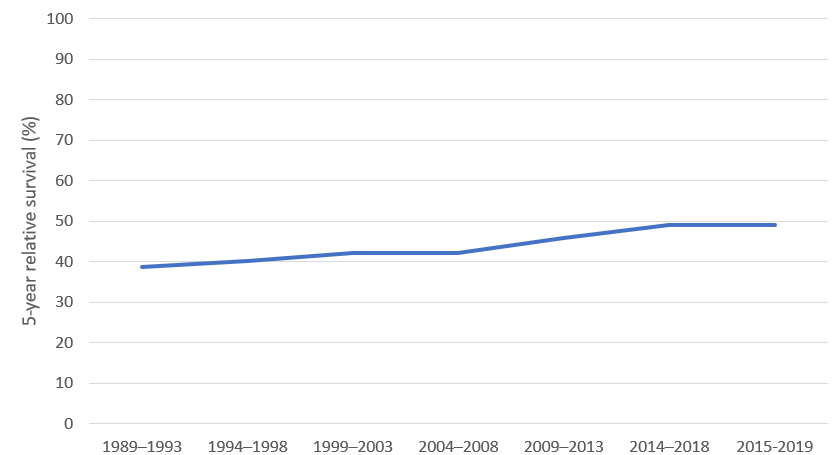
Notes
- Data sourced from AIHW Cancer Data in Australia 2023 web report and supplementary data tables
- More information about 5-year relative survival rates for ovarian cancer over time, by age, sex, Indigenous status, remoteness, and socioeconomic status (SES) can be found on the NCCI website in the ‘Relative survival rate’ section (https://ncci.canceraustralia.gov.au/outcomes/relative-survival-rate/5-year-relative-survival-diagnosis)
Prevalence
At the end of 2018, there were 1,453 people living who had been diagnosed with ovarian cancer (incl. serous carcinomas of the fallopian tube) that year, 5,173 people living who had been diagnosed with ovarian cancer (incl. serous carcinomas of the fallopian tube) in the previous 5 years (from 2014 to 2018) and 13,658 people living who had been diagnosed with ovarian cancer (incl. serous carcinomas of the fallopian tube) in the previous 36 years (from 1982 to 2018).
For more information, see Ovarian cancer on the NCCI website
The National Cancer Control Indicators (NCCI) are a set of indicators across the continuum of cancer care, from Prevention and Screening through to Diagnosis, Treatment, Psychosocial care, Research and Outcomes. The NCCI website allows users to see visual representations of data on each indicator through interactive charts.
Useful links
- Ovarian Cancer Australia
- Cancer Council, Ovarian cancer
- Cancer Council, Ovarian cancer: your guide to best cancer care
- Australian Cancer Trials
- American Cancer Society, Ovarian cancer
- Ovarian Epithelial, Fallopian Tube, and Primary Peritoneal Cancer Treatment (PDQ®)
- Ovarian Germ Cell Tumors Treatment (PDQ®)
- Ovarian Low Malignant Potential Tumors Treatment (PDQ®)
- National Comprehensive Cancer Network (US), NCCN guidelines for patients

